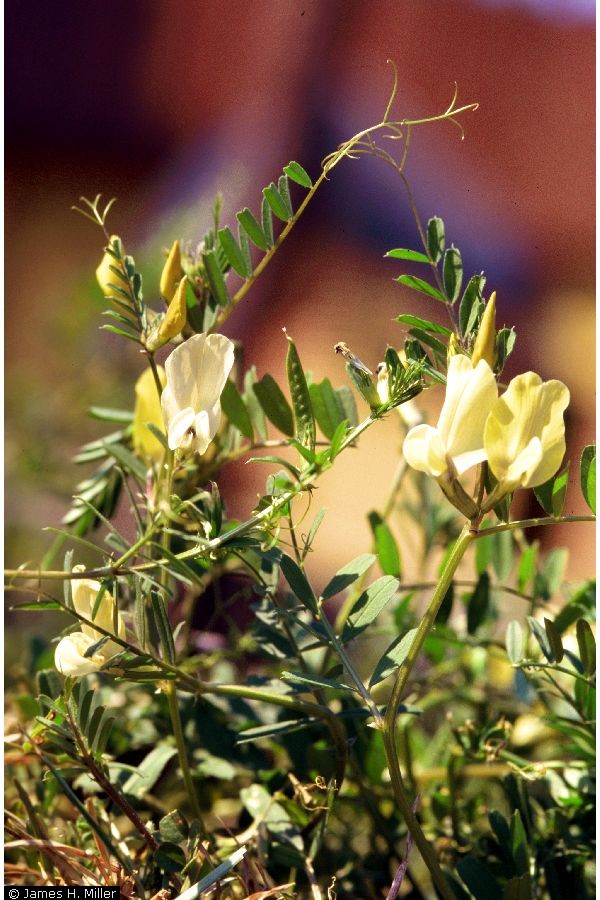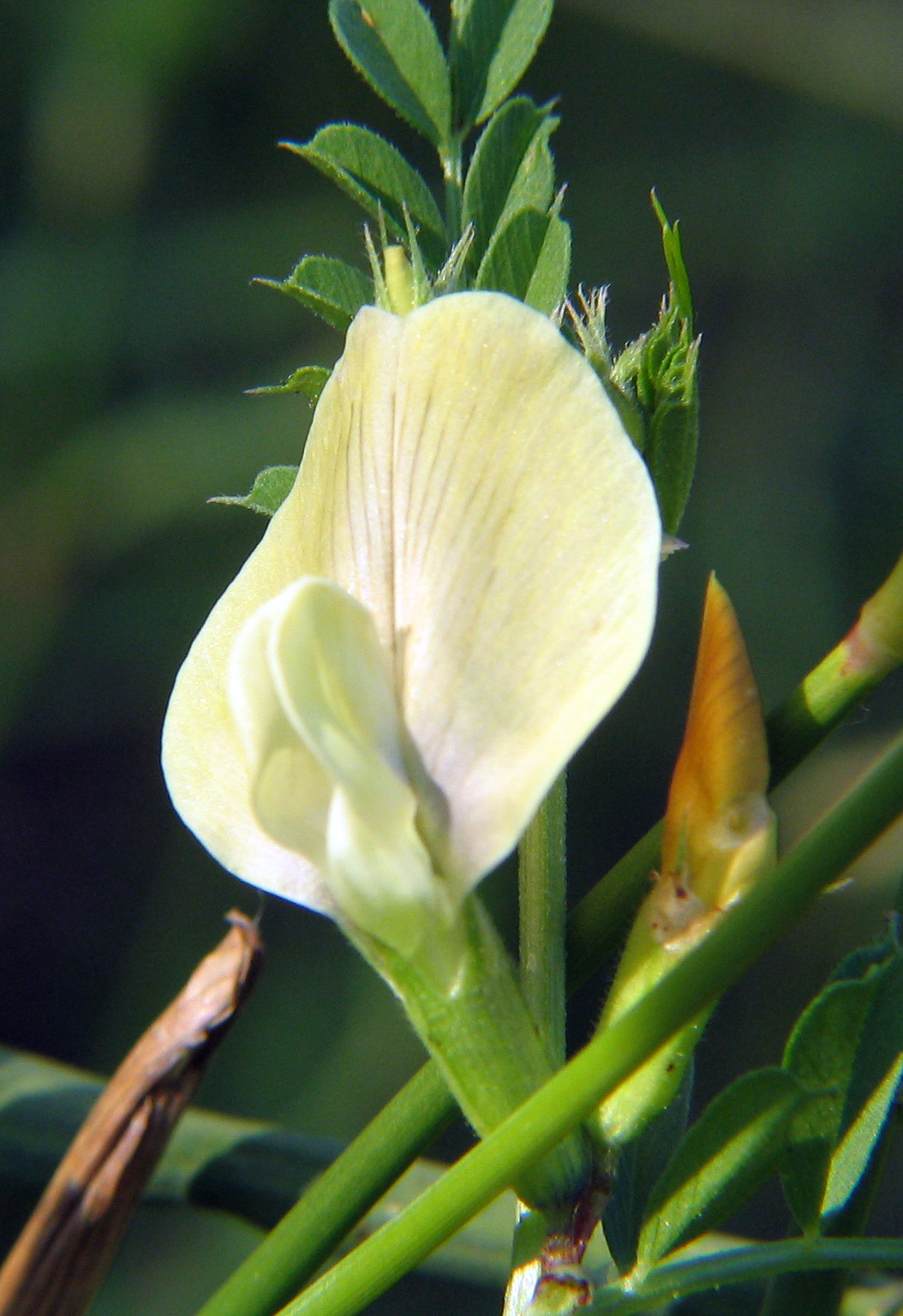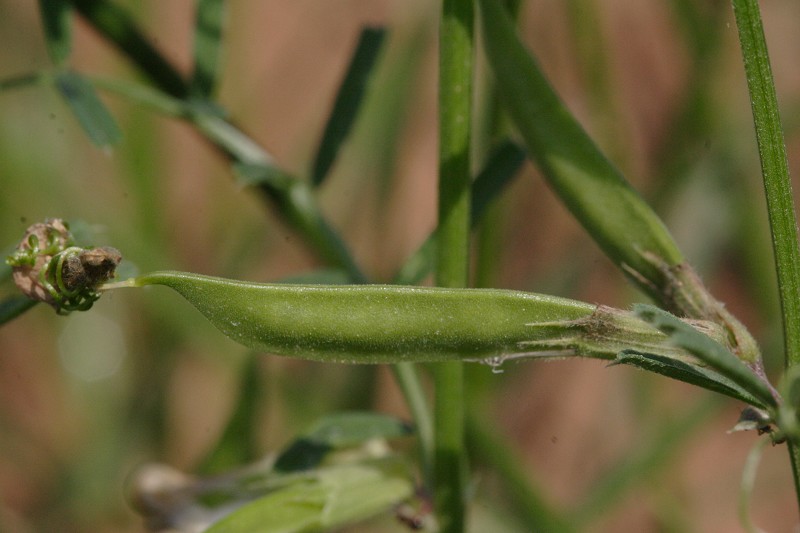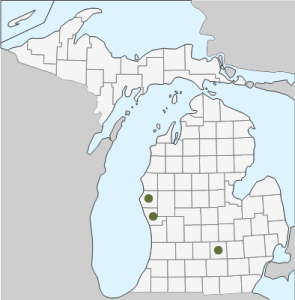 Download PDF
Download PDF
Name: Vicia grandiflora Scop.
Family: Fabaceae, the pea family
Common Names: Large-flowered vetch, large yellow vetch, bigflower vetch (3,8).
 Etymology: Vicia is the Latin word for “vetch”, and grandiflora means “large-flowered” (4).
Etymology: Vicia is the Latin word for “vetch”, and grandiflora means “large-flowered” (4).
Botanical synonyms: none found.
Quick Notable Features (5,7):
¬ Herbaceous vine with compound leaves (6-14 leaflets) ending in a forked tendril
¬ Large yellowish flowers, usually paired in the upper leaf axils, with a calyx covered in fine hairs
¬ The hilum occasionally covers over 70% of the seed circumference
Plant Height: Stems can grow up to 60cm long (5,6,7).
Subspecies/varieties recognized (2):
V. grandiflora var. biebersteinii Griseb.
V. grandiflora var. dissecta Boiss.
V. grandiflora var. kitaibeliana W.D.J. Koch
V. grandiflora var. sordida Griseb.
V. grandiflora subsp. grandiflora
V. grandiflora subsp. sordida Dostál
Most Likely Confused with: Vicia lathyroides, V. sativa, V. villosa, V. americana, V. cracca, V. faba, or species of Lathyrus.
Habitat Preference: Open sites and woods, abandoned fields, and on roadsides (5,7).
Geographic Distribution in Michigan: V. grandiflora is only found in Ingham and Oceana counties (3).
Known Elevational Distribution: The species was collected at 1,720m above sea level in Armenia (9).
Complete Geographic Distribution: Native to Europe, V. grandiflora is found mainly in the southeastern United States (AL, AR, DE, FL, GA, KY, LA, MA, MD, MI, MO, MS, NC, NJ, NY, SC, TN, VA, WV). It is also found in Armenia, Austria, Azerbaijan, Belgium, Bosnia & Herzegovina, Brazil, Bulgaria, Croatia, Czech Republic, France, Georgia, Germany, Greece, Hungary, Italy, Luxembourg, Netherlands, Norway, Poland, Slovakia, Slovenia, Sweden, Switzerland, Syrian Arab Republic, Tajikistan, Turkey, Ukraine, and the United Kingdom (8,9).
 Vegetative Plant Description: V. grandiflora is an annual, herbaceous vine with branching stems that are finely pubescent to glabrous. The stipules of the upper and lower leaves are differentiable: the upper are entire, ovoid, and 2-3mm long, while the lower are lanceolate, longer, and have coarsely serrated margins (3-4mm long). The leaves are alternately arranged and pinnately compound, with 6-14 e-stipellate leaflets with glands beneath. The terminal leaflet is modified into a forked tendril. The leaflets are obovate, up to 2cm long with approximately 12 pairs of secondary veins (pinnately veined) (6,7,10).
Vegetative Plant Description: V. grandiflora is an annual, herbaceous vine with branching stems that are finely pubescent to glabrous. The stipules of the upper and lower leaves are differentiable: the upper are entire, ovoid, and 2-3mm long, while the lower are lanceolate, longer, and have coarsely serrated margins (3-4mm long). The leaves are alternately arranged and pinnately compound, with 6-14 e-stipellate leaflets with glands beneath. The terminal leaflet is modified into a forked tendril. The leaflets are obovate, up to 2cm long with approximately 12 pairs of secondary veins (pinnately veined) (6,7,10).
Climbing Mechanism: Foliar tendrils allow climbing (7).
Flower Description: V. grandiflora flowers (2.6-3.5cm long) are perfect, zygomorphic, and are borne in nearly sessile (pedicels are 2-8mm long) clusters of usually two flowers, in the upper leaf axils. The calyx tube (0.6-1cm long) is short, pubescent to glabrous, and the pilose lobes (5) are nearly half as long as the tube. The petals (5) are yellowish or white; the standard and keel petals are sometimes tinged with purple. The standard is obovate and overlaps the wings. The wing petals are narrower than the standard, about the same length as the calyx tube, and adherent to the keel petals, which are shorter than the wings. The stamens are 10 (fused as 9+1). The ovary is sessile or nearly so; the style is filiform with trichomes at the apex (5,6,7).
Flowering Time: V. grandiflora flowers in spring (April-June) (7).
Pollinator: Vicia grandiflora is insect pollinated, like other members of Vicia. Various bees are known to visit the plant for nectar including bumblebees, Apis mellifera, Eucera, Anthophora, Andrena, and Halictus species (13).
 Fruit Type and Description: V. grandiflora bears a compressed legume that is hairless or slightly pubescent, and turns from green to black at maturity (May-July). The legumes are usually 3.5-5cm long, 0.6-0.8cm wide, and contain at least 2 seeds (5,7).
Fruit Type and Description: V. grandiflora bears a compressed legume that is hairless or slightly pubescent, and turns from green to black at maturity (May-July). The legumes are usually 3.5-5cm long, 0.6-0.8cm wide, and contain at least 2 seeds (5,7).
Seed Description: The seeds are reniform (kidney shaped), <4mm long and about 3mm broad, reddish brown with darker spots, or black. An attachment scar, the hilum, occasionally covers over 70% of the seed circumference (12).
Dispersal Syndrome: Vicia grandiflora is a self-reseeding species, demonstrated in experimental inter-seeding in farming and agriculture (16). Further, birds often eat the seeds (14), but there is no evidence confirming that the seeds are still viable after predation.
 Distinguished by: V. grandiflora has more leaflets than Vicia lathyroides (only 4-8 leaflets). and V. lathyroides has unforked tendrils. The flowers of V. lathyroides are bluish in color, not paired or grouped, and they are much smaller (<1cm long) than the flowers of V. grandiflora. V. lathroyides also has quadrate seeds. V. sativa has about the same number of leaflets as V. grandiflora, occasionally a couple more, but the leaflets are longer (1.5-3.5cm long) and often pubescent. The flowers of V. sativa are roughly the same size as in V. grandiflora, also paired, but the corolla is purple with violet wings and the lobes of the sepals exceed the calyx tube in length. V. villosa, V. americana, V. cracca, and V. faba’s inflorescences are pedunculate and racemose, bearing 3 to many flowers. V. villosa, as suggested by its name, has visibly villous stems. Additionally, the leaflets can be more numerous (10-20), the calyx is irregular and swollen at the base, and the corolla is usually purple. V. americana has longer leaflets (1.5-3cm long), the base of the calyx is also swollen (not as much as V. villosa, but very similar to V. cracca), and the corolla is bluish-purple. V. cracca has the same number of leaflets as V. villosa, each leaflet the same length as V. americana, but all stipules are entire. The flowers are blue and densely clustered. V. faba only grows to 20cm tall, does not have tendrils (not a climber), and the leaflets are less numerous (4-6) and longer (5-10cm long). Lathyrus ssp. are generally similar to Vicia. The flowers of Lathyrus ssp. can be differentiated by mostly free wings, which are adherent to the keel petals in Vicia ssp., and the widened, flattened style with hairs along the inner side, in comparison to the filiform style with apical hairs found in Vicia (5,6,7,17).
Distinguished by: V. grandiflora has more leaflets than Vicia lathyroides (only 4-8 leaflets). and V. lathyroides has unforked tendrils. The flowers of V. lathyroides are bluish in color, not paired or grouped, and they are much smaller (<1cm long) than the flowers of V. grandiflora. V. lathroyides also has quadrate seeds. V. sativa has about the same number of leaflets as V. grandiflora, occasionally a couple more, but the leaflets are longer (1.5-3.5cm long) and often pubescent. The flowers of V. sativa are roughly the same size as in V. grandiflora, also paired, but the corolla is purple with violet wings and the lobes of the sepals exceed the calyx tube in length. V. villosa, V. americana, V. cracca, and V. faba’s inflorescences are pedunculate and racemose, bearing 3 to many flowers. V. villosa, as suggested by its name, has visibly villous stems. Additionally, the leaflets can be more numerous (10-20), the calyx is irregular and swollen at the base, and the corolla is usually purple. V. americana has longer leaflets (1.5-3cm long), the base of the calyx is also swollen (not as much as V. villosa, but very similar to V. cracca), and the corolla is bluish-purple. V. cracca has the same number of leaflets as V. villosa, each leaflet the same length as V. americana, but all stipules are entire. The flowers are blue and densely clustered. V. faba only grows to 20cm tall, does not have tendrils (not a climber), and the leaflets are less numerous (4-6) and longer (5-10cm long). Lathyrus ssp. are generally similar to Vicia. The flowers of Lathyrus ssp. can be differentiated by mostly free wings, which are adherent to the keel petals in Vicia ssp., and the widened, flattened style with hairs along the inner side, in comparison to the filiform style with apical hairs found in Vicia (5,6,7,17).
Other members of the family in Michigan (number species): Amorpha (2), Amphicarpaea (1), Anthyllis (1), Apios (1), Astragalus (3), Baptisia (3), Caragana (1), Cercis (1), Chamaecrista (2), Colutea (1), Crotalaria (1), Cytisus (1), Dalea (2), Desmanthus (1), Desmodium (12), Galega (1), Gleditsia (2), Glycine (1), Gymnocladus (1), Hedysarum (1), Hylodesmum (2), Kummerowia (1), Lathyrus (9), Lespedeza (9), Lotus (1), Lupinus (3), Medicago (3), Melilotus (3), Mimosa (1), Orbexilum (1), Phaseolus (2), Pisum (1), Pueraria (1), Robinia (3), Securigera (1), Senna (2), Strophostyles (1), Tephrosia (1), Trifolium (10), Vicia (9), Vigna (1), and Wisteria (2) (source 3).
Ethnobotanical Uses: No medicinal uses for V. grandiflora were found in the literature, but the leaves are edible and can be used in salads (15). Some Vicia spp. are known to contain toxic substances in their seeds, thus the ingestion of V. grandiflora seeds is not recommended (18).
 Phylogenetic Information: Vicia is a member of the subfamily Faboideae in the Fabaceae family, which is in the order Fabales, superorder Rosanae, subclass Magnoliidae. Members of the Fabaceae family are distributed worldwide, and the family contains approximately 9.4% of all eudicots and 16% of all known woody plants found in neotropical rainforests (1).
Phylogenetic Information: Vicia is a member of the subfamily Faboideae in the Fabaceae family, which is in the order Fabales, superorder Rosanae, subclass Magnoliidae. Members of the Fabaceae family are distributed worldwide, and the family contains approximately 9.4% of all eudicots and 16% of all known woody plants found in neotropical rainforests (1).
Interesting Quotation or Other Interesting Factoid not inserted above: A study to determine the best winter cover crop for no-till corn production compared the nitrogen that is biologically fixed by V. grandiflora, V. villosa, and Trifolium incarnatum, to the commonly used cover grass Secale cereal (rye). V. villosa was shown to be a better cover crop than V. grandiflora and the other species, in terms of dry matter and nitrogen production (11).
Literature and websites used:
- Stevens, P.F. Angiosperm Phylogeny Website. Ver. 9 June 2008. http://www.mobot.org/mobot/research/apweb.
- Tropicos.org. Missouri Botanical Garden. 06 Mar 2012 http://www.tropicos.org/Name/13034790
- Michigan Flora Online. A.A. Reznicek, E.G. Voss, & B.S. Walters. February 2011. University of Michigan. Web. 3-6-2012. http://michiganflora.net/home.aspx.
- Brown, R.W. 1956. Composition of Scientific Words. Washington, D.C.: Smithsonian Institution Press.
- Fernald, M.L. 1950. Gray’s Manual of Botany, 8th ed. New York: American Book Company.
- Gleason, H.A. 1963. Illustrated Flora of the Northeastern United States and Adjacent Canada, Volume 2. New York, NY: Hafner Publishing Company, Inc.
- Radford, A.E., H.E. Ahles, & C.R. Bell 1968. Manual of the Vascular Flora of the Carolinas. Chapel Hill, NC: The University of North Carolina Press.
- USDA, NRCS. 2012. The PLANTS Database (http://plants.usda.gov, 03/06/2012). National Plant Data Team, Greensboro, NC 27401-4901 USA.
- Biodiversity occurrence data (via GBIF Data Portal, data.gbif.org, 03/05/2012)
- Gleason, H.A. & A. Cronquist 1963. Manual of Vascular Plants of the Northeastern United States and Adjacent Canada. Princeton, NJ: D. Van Nostrand Company, Inc.
- Ebelhar, S.A., W.W. Frye, & R.L. Blevins 1982. Nitrogen from Legume Cover Crops for No-Tillage Corn. Agronomy Journal 76(1): 51-55.
- Perrino, P., M. Yarwood, P. Hanelt, & G.B. Polignano 1983. Variation of seed characters in selected Vicia species. Genetic Resources and Crop Evolution 32(2): 103-122.
- Grozdanic, S. 1970. Flower visits of insects to some species of Vicia (Leguminosae). Journal Zbornik Matice Srpske 38: 83-90.
- Miller, J.H. & K.V. Miller 2005. Forest plants of the Southeast and their wildlife uses. Athens, Georgia: The University of Georgia Press.
- Plants For A Future, 1996-2010. Vicia grandiflora kitaibeliana. http://www.pfaf.org/user/Plant.aspx?LatinName=Vicia+grandiflora+kitaibeliana
- Boquet, D.J. & S.M. Dabney 1991. Research in biomass and nitrogen content of selected winter legumes in grain Sorghum culture. Agronomy Journal 83(1): 144-148.
- Weakley, A.S. 2010. Flora of the Southern and Mid-Atlantic States. University of North Carolina at Chapel Hill.
- Enneking, D. 1994. The toxicity of Vicia species and their utilization as grain legumes. Ph.D. (Ag.Sc.) thesis, University of Adelaide.
Image Credits (all used with permission):
1) Image of plant with flowers courtesy of James H. Miller, http://plants.usda.gov/java/largeImage?imageID=vigr_002_avp.tif
2) Image of flower courtesy of Wikipedia User Bogdan, licensed under the creative commons Available online at: http://commons.wikimedia.org/wiki/File:Vicia_grandiflora_bgiu_01.jpg
3) Image of fruit copyright by John R. Gwaltney and made available for educational use http://www.southeasternflora.com/view_flora.asp?plantid=352#
4) Image of seeds courtesy of Steve Hurst, http://plants.usda.gov/java/largeImage?imageID=vigr_001_ahp.tif
5) Species distribution map, derived from the Michigan Flora Online.
Primary Authors: Cristine V. Santanna with revisions and editing by John Bradtke, Jenna Dorey and Robyn J. Burnham.
© Robyn J. Burnham, University of Michigan
For additional information on Michigan Plant Diversity web pages please contact Robyn J. Burnham via email: rburnham“at”umich.edu